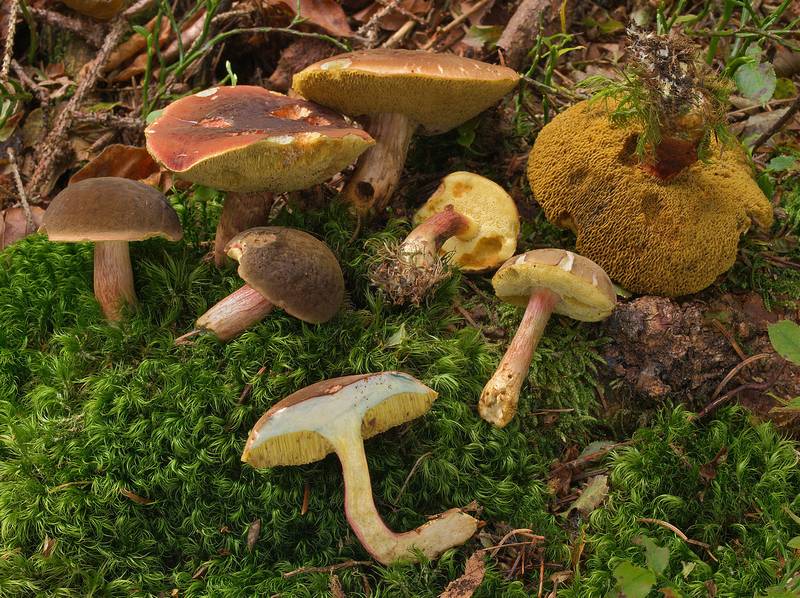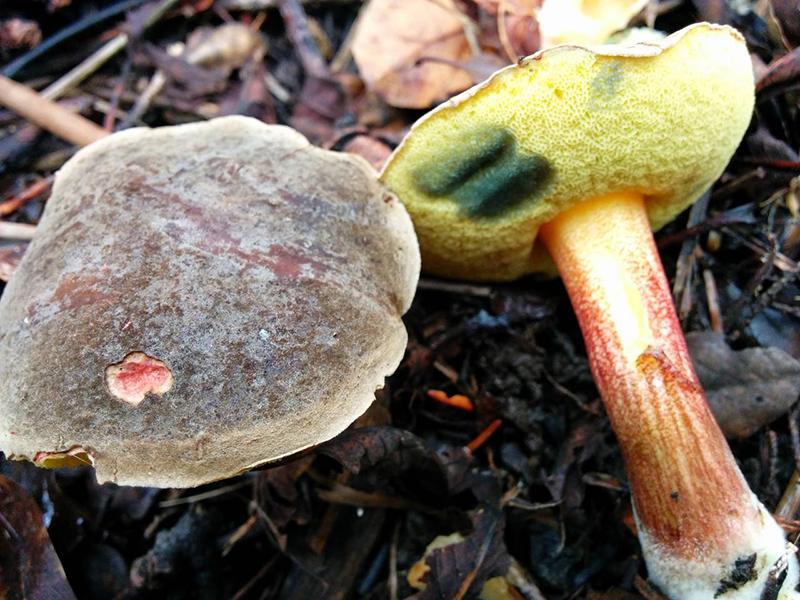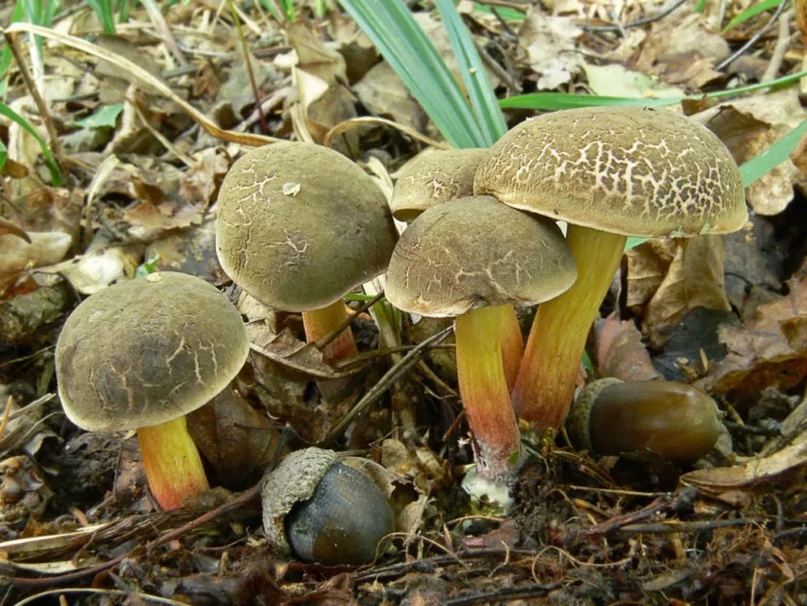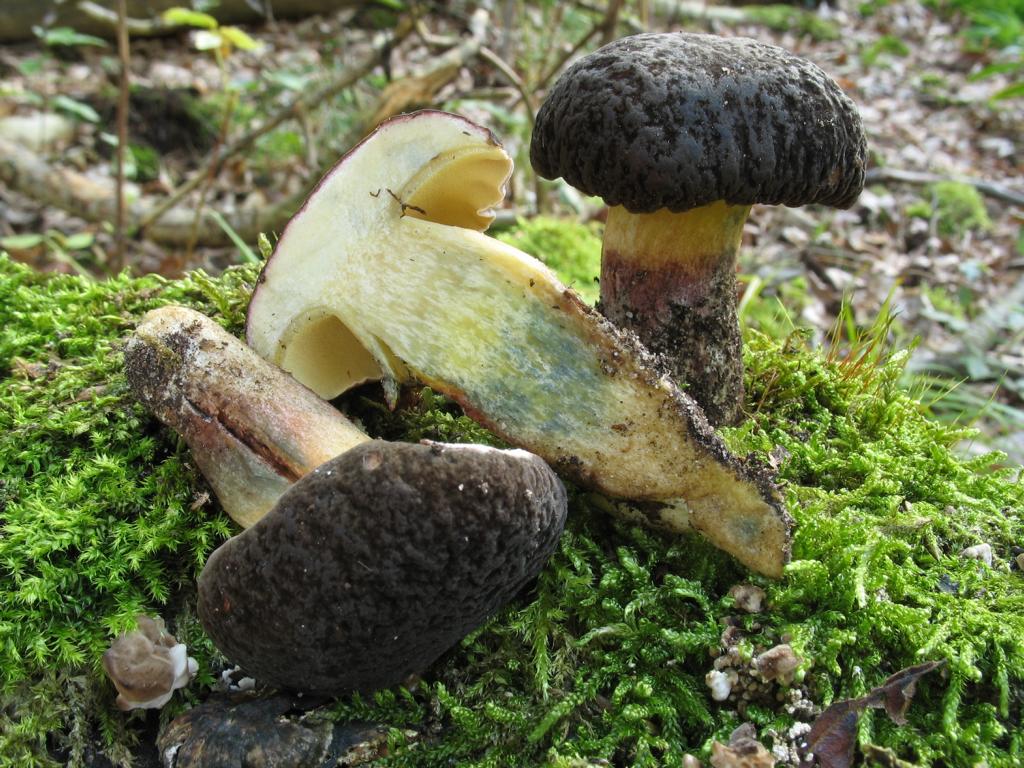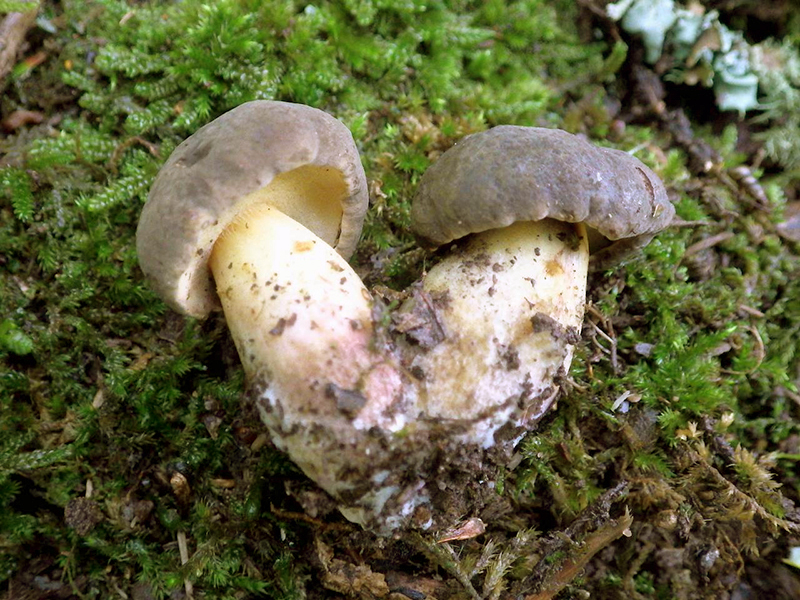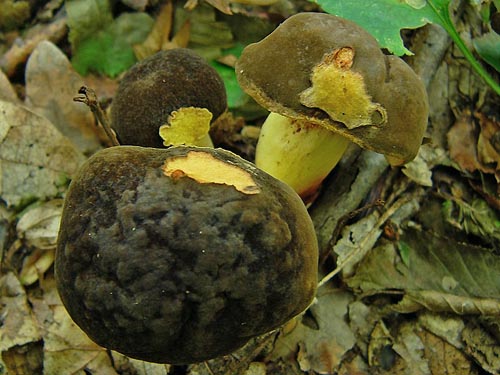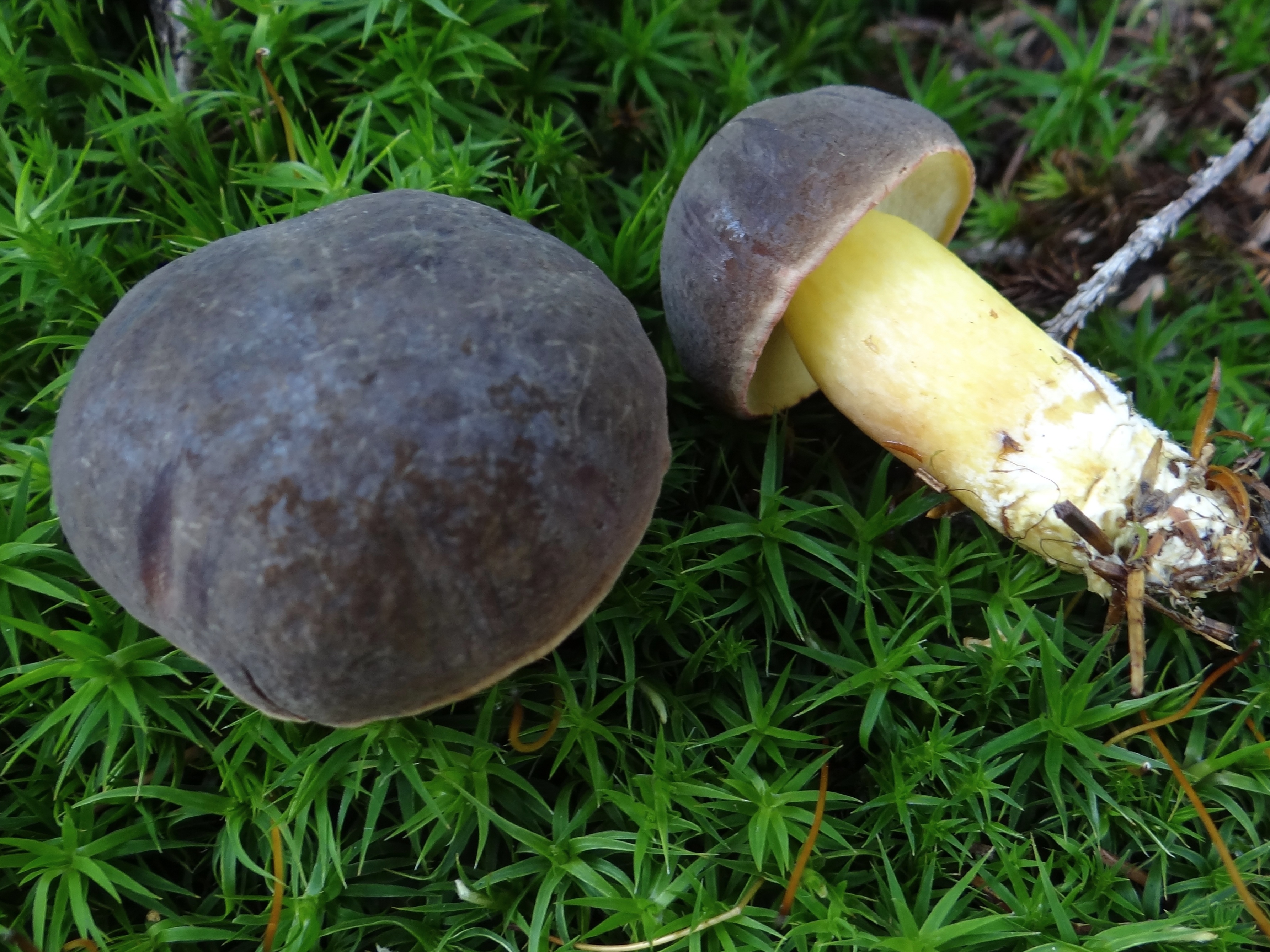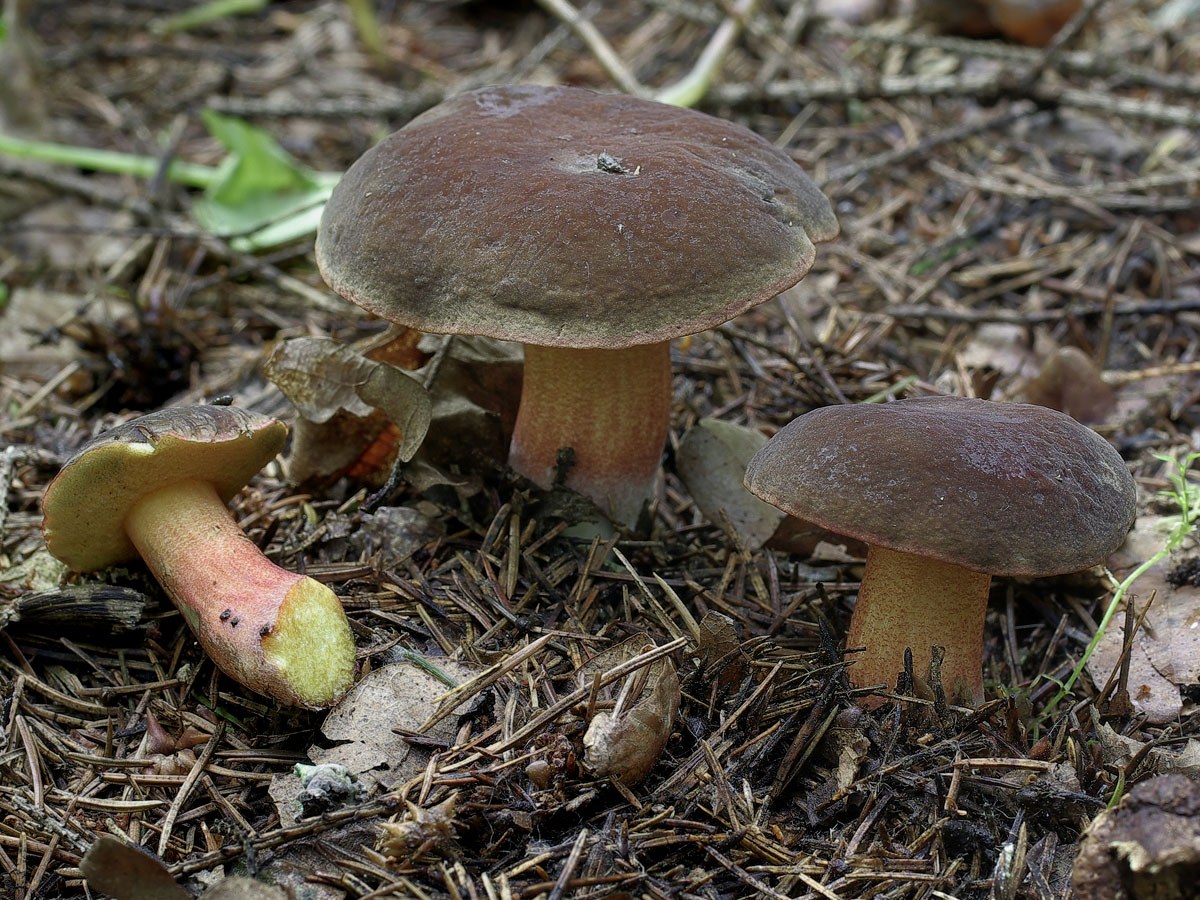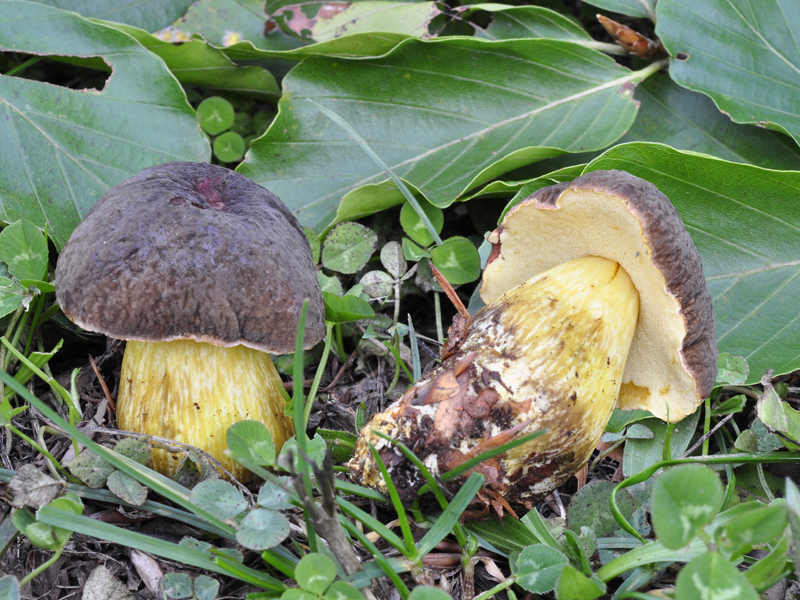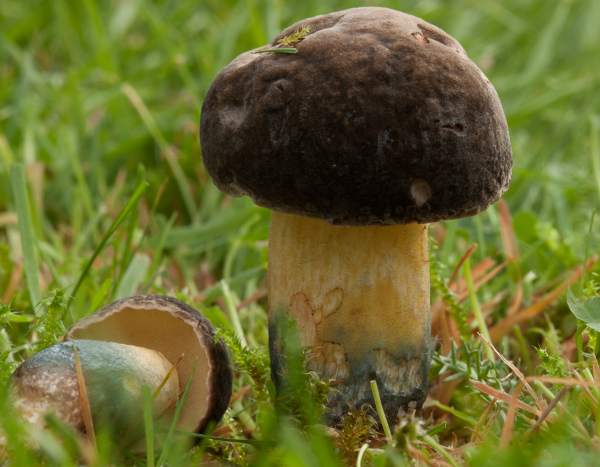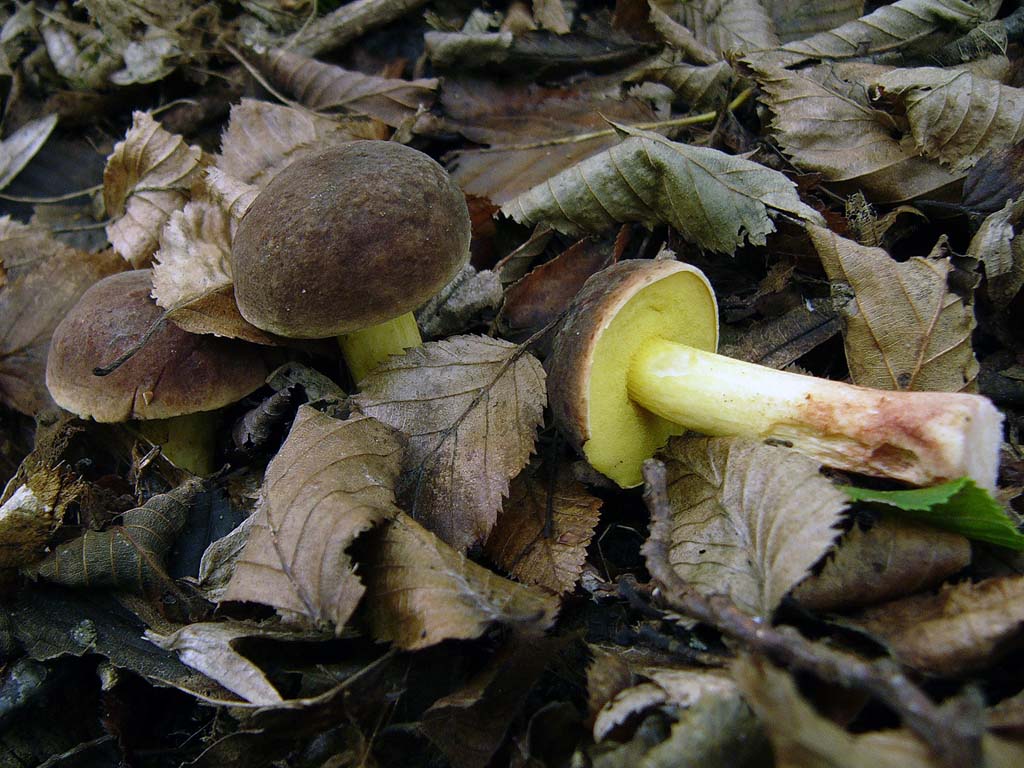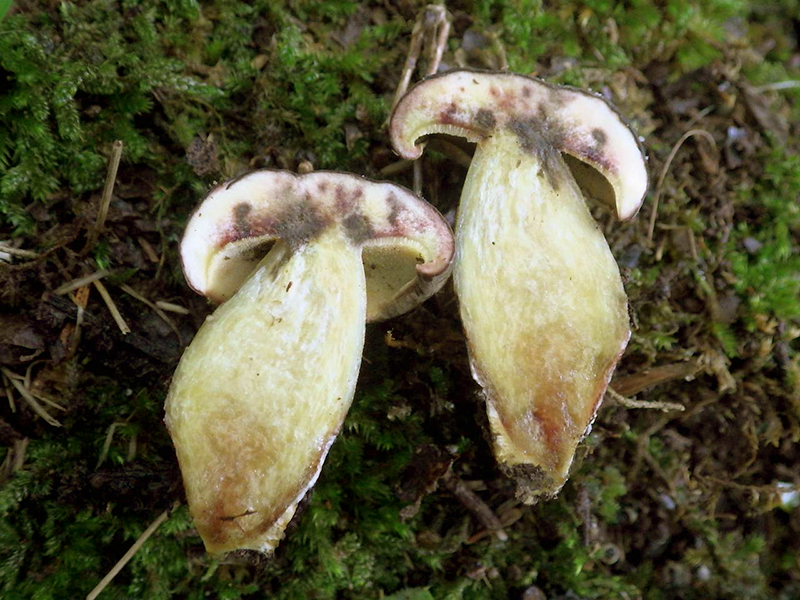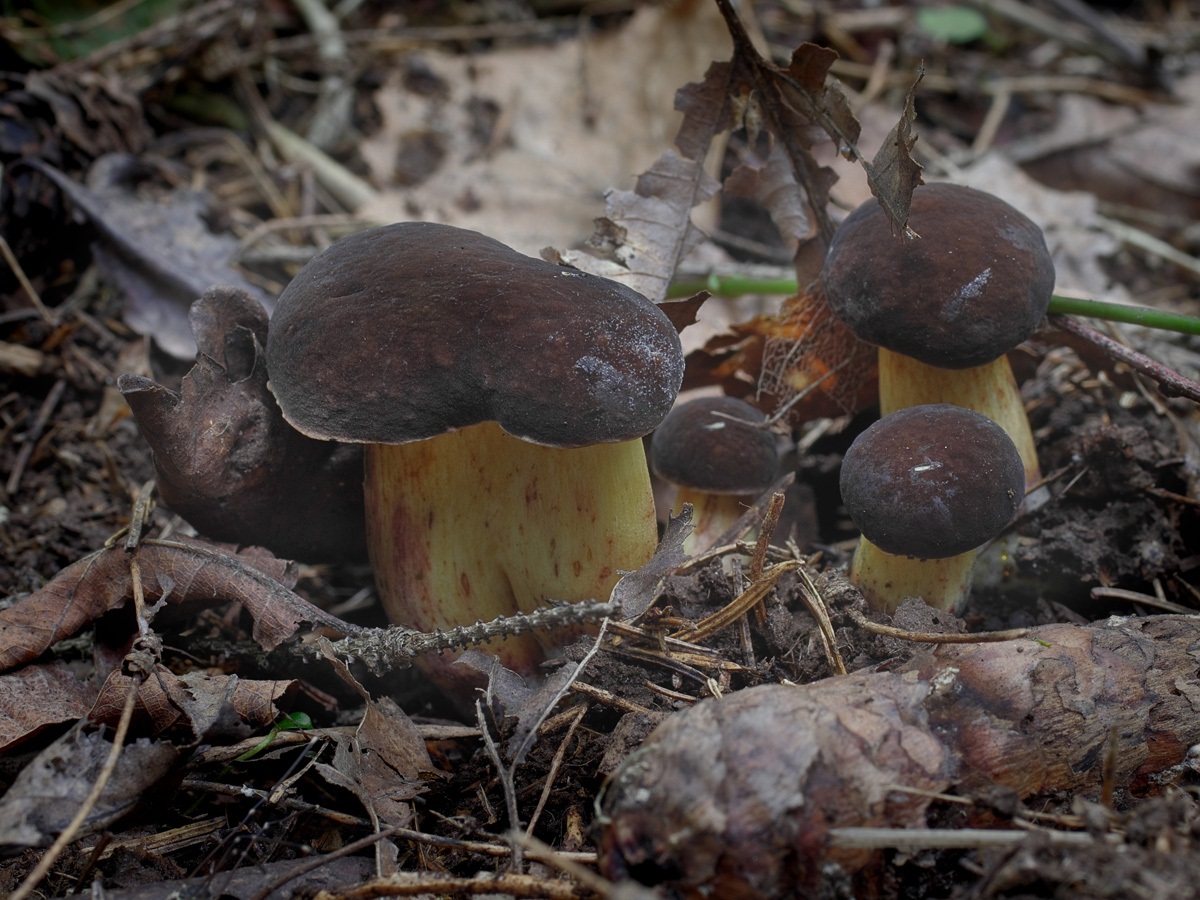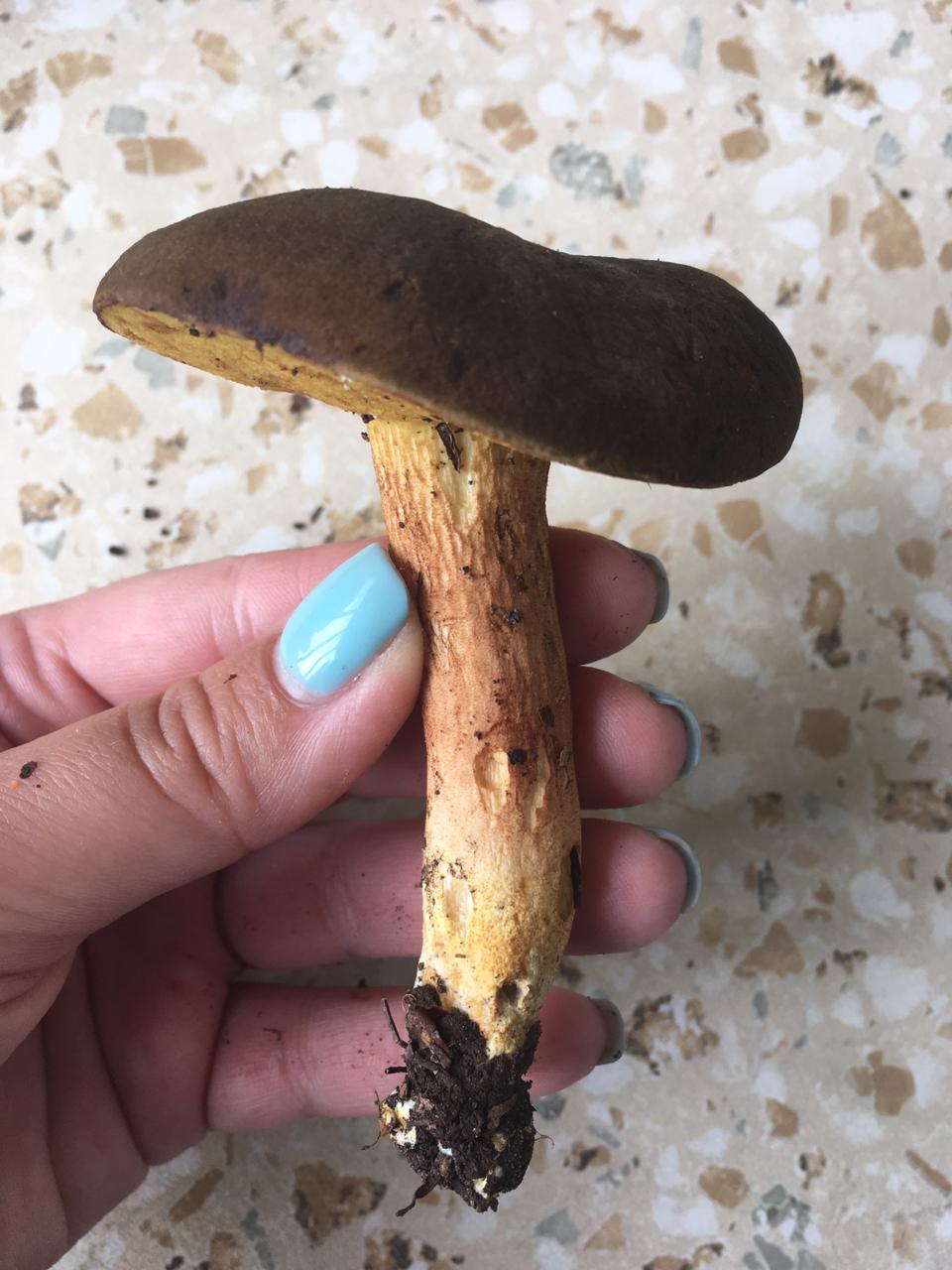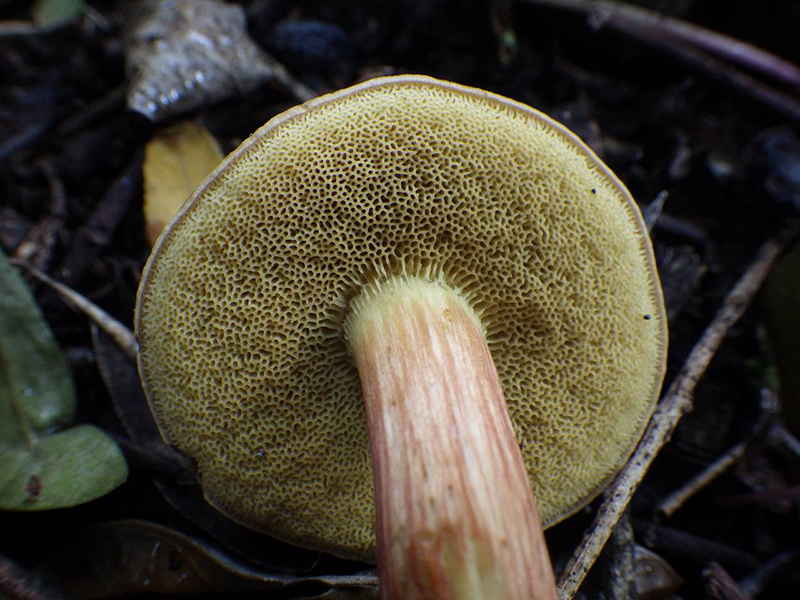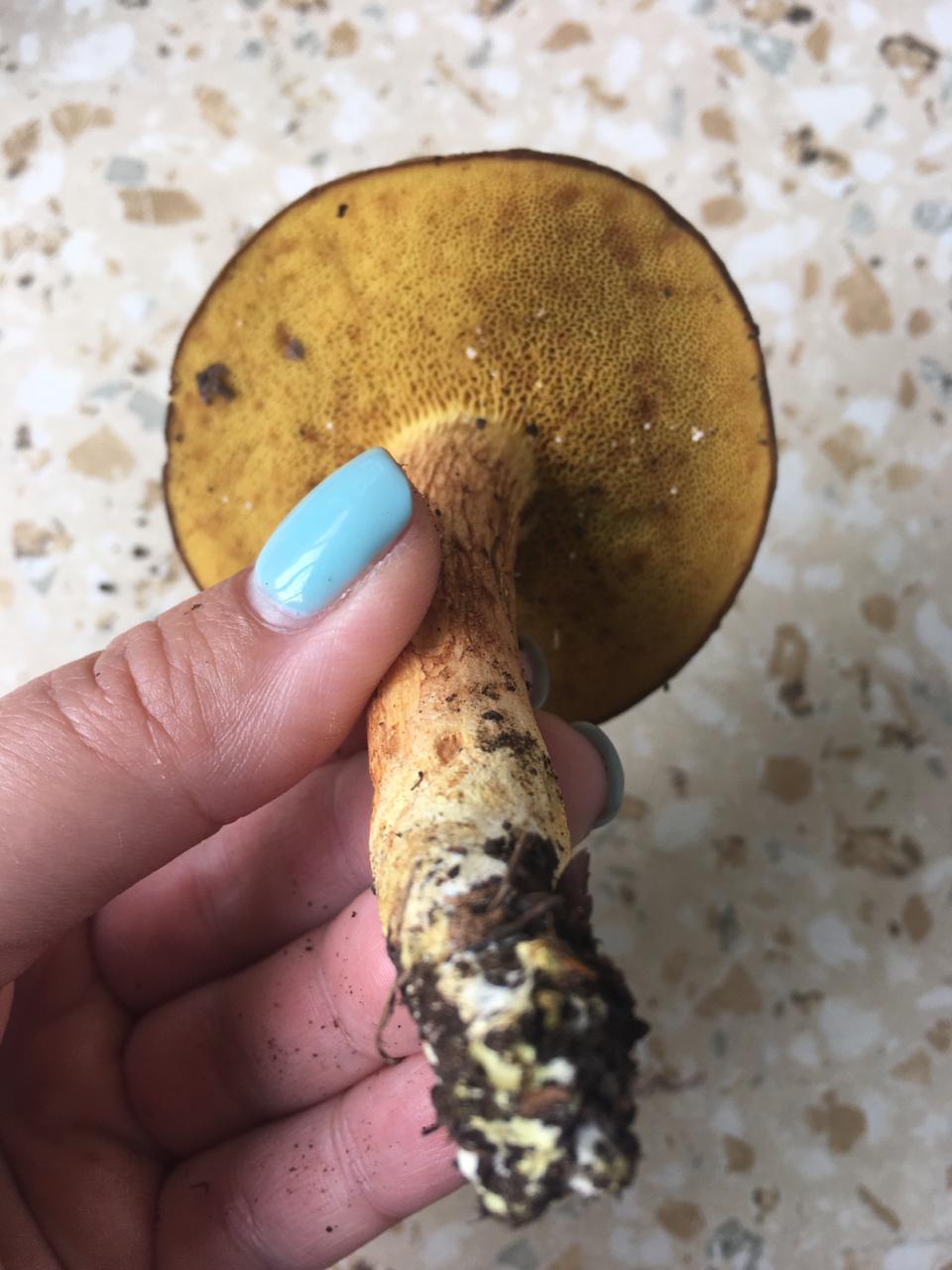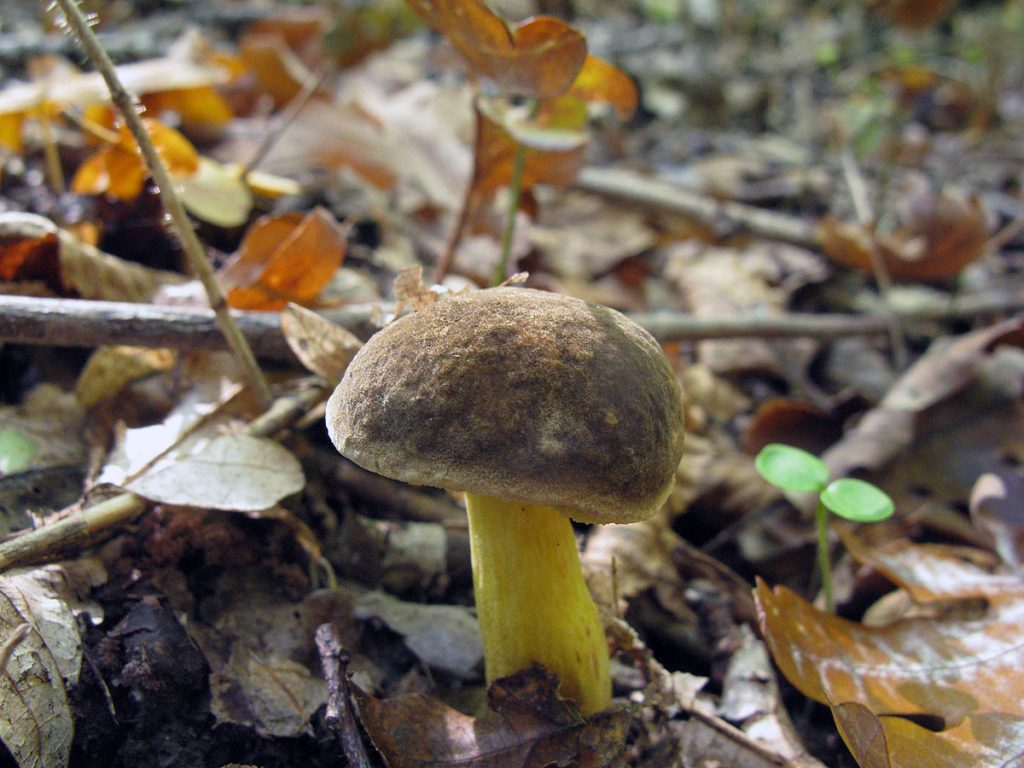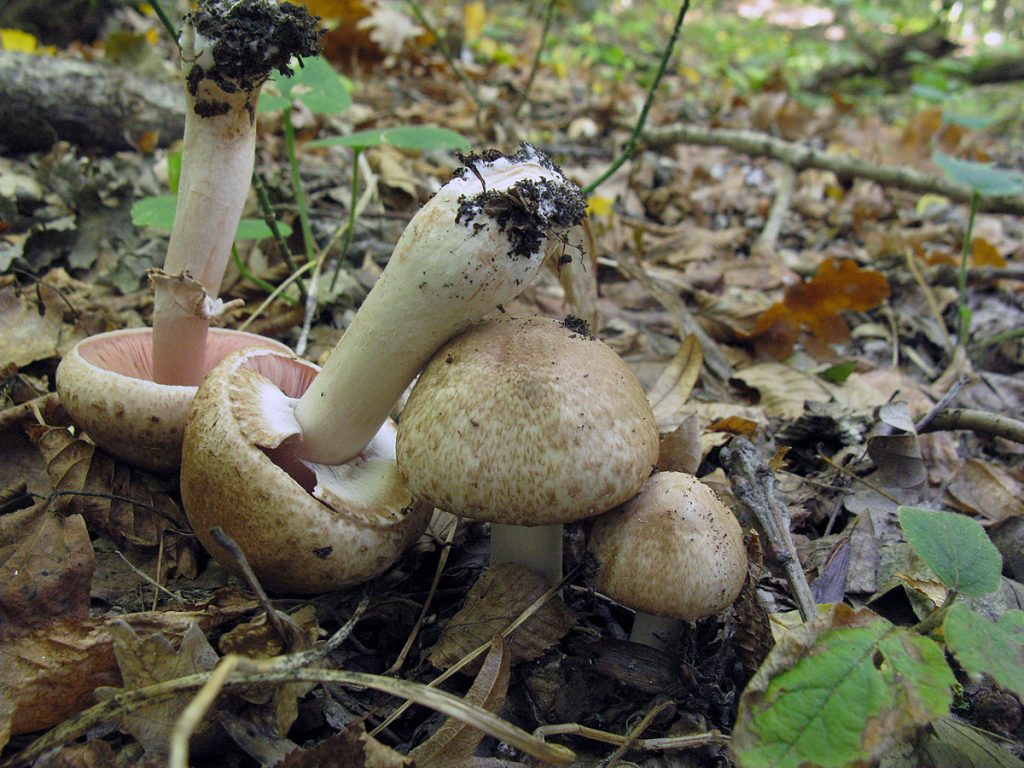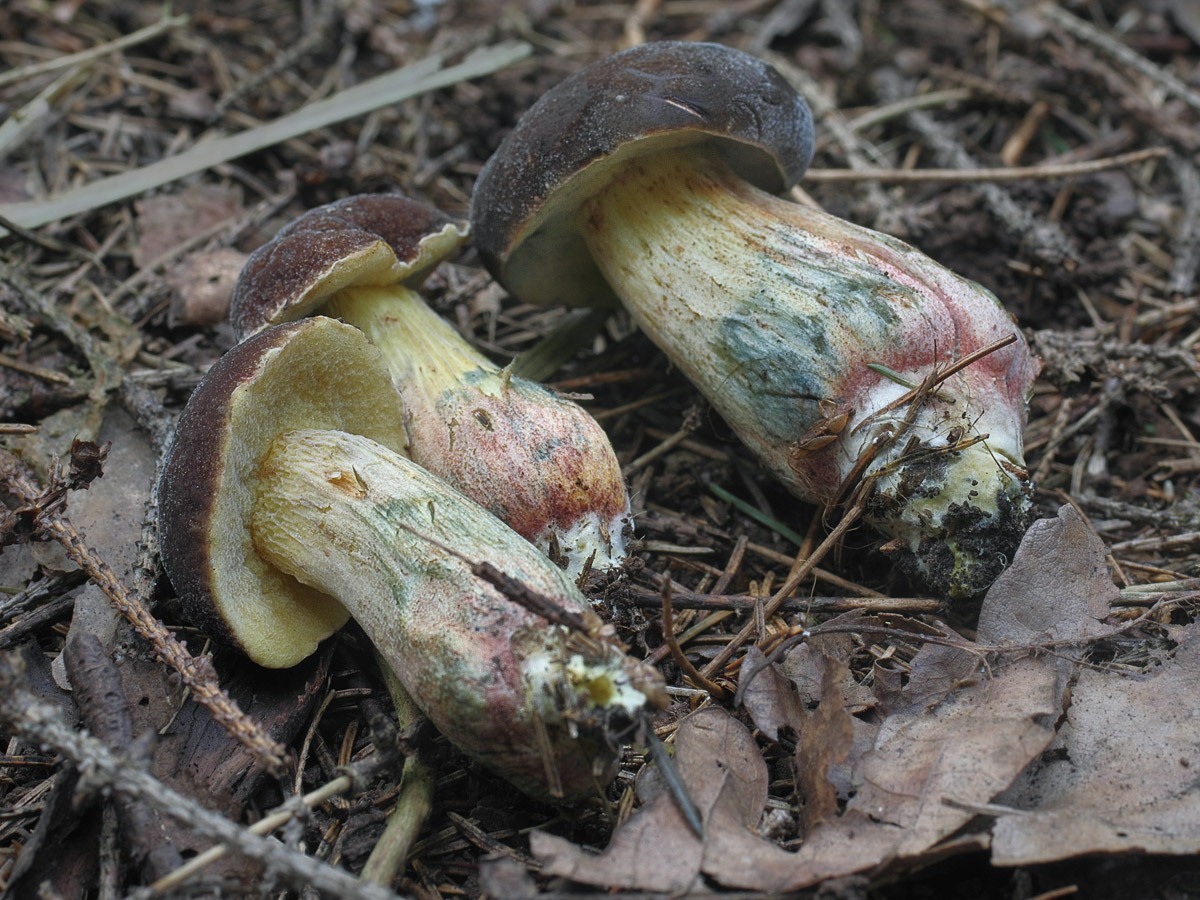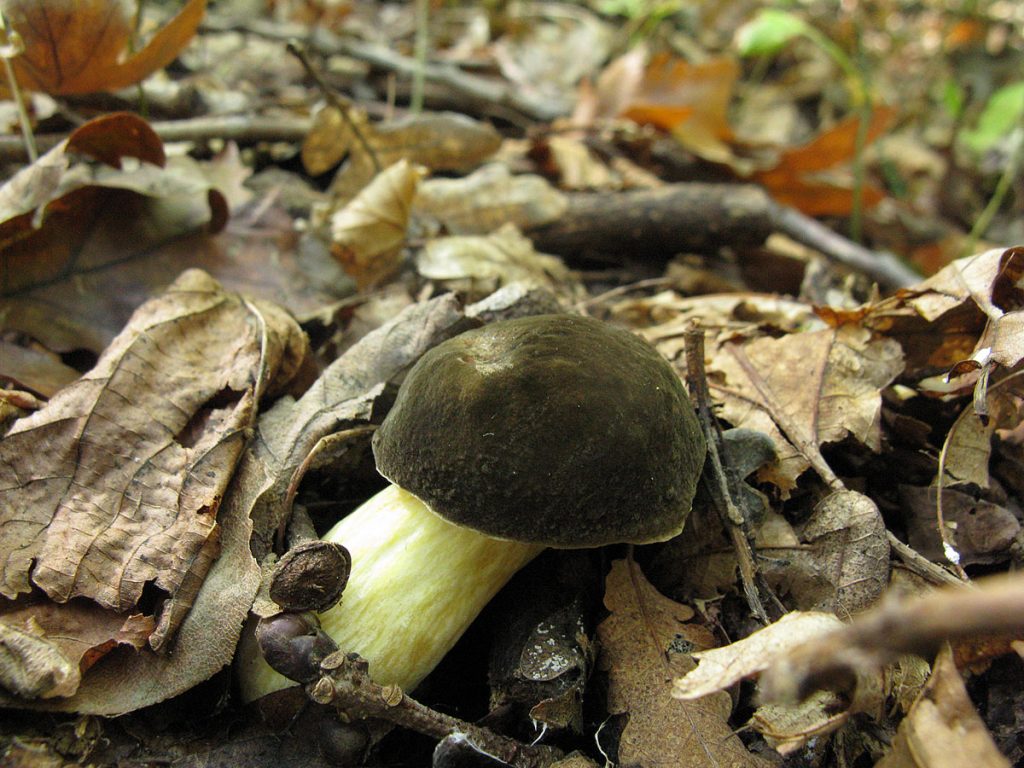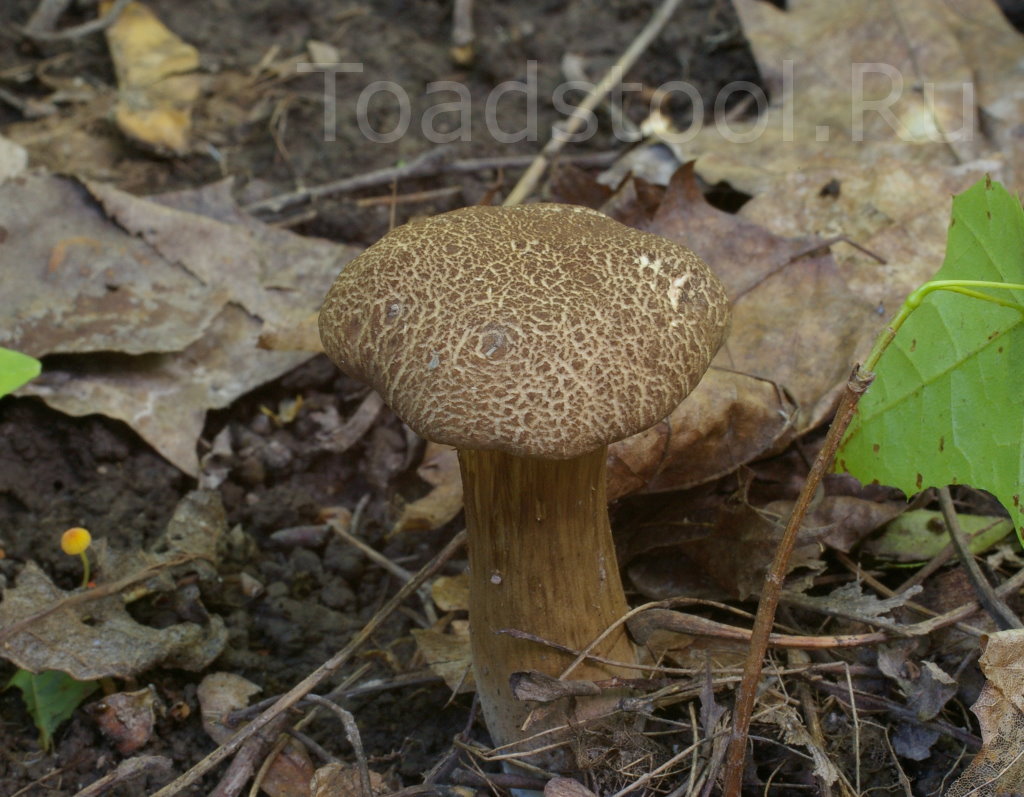How to distinguish from edible mushrooms?
It is not easy to understand exactly what type of flywheel is in front of you, due to the fact that there are about 18 species of them, which differ in size and appearance.
First of all, it is necessary to pay attention to the place of growth - these should be various types of moss, which is already laid down in the name. And also if you press the tubular surface of a real flywheel, then a bluish trace should remain
In theory, it is believed that there are no false, that is, poisonous, mushrooms, but in fact, these species are avoided due to their very bad taste. Unfortunately, the absence of toxic twins dulls the vigilance of mushroom pickers, and they do not always check all the signs of a false flywheel, which can also be confused with boletus or boletus.
By their appearance, they can be distinguished by their color - they have a white, dirty pinkish, light brown tubular layer uncharacteristic for a flywheel.
Conditionally edible mushrooms may look better compared to others, as insects rarely attack them due to their unpleasant taste.
Similar species
The cap is fleshy, convex, 5-10 cm in diameter. Sometimes it is flat. The surface of the cap is ocher-yellow, brownish, with small, thin, later disappearing, fibrous scales. Usually dry, mucous in wet weather. The surface of the tubular layer is initially dull yellow or dirty yellow, eventually becomes tobacco brown. The pores are smallish, rounded. The leg of the yellow-brown oiler is not very large: 5-8 cm high and 1-2 cm thick. The color of the leg is yellowish or brownish, usually it is buried in moss and is not very visible. The dense flesh at the break turns slightly blue.
Yellow-brown moss grows in pine forests on peaty-sandy or sandy soils. These edible mushrooms are very fruitful. They are rarely affected by insect larvae. They bear fruit from August to October. They are eaten freshly prepared, dried or pickled.

Photo by: Strobilomyces, CC BY-SA 3.0
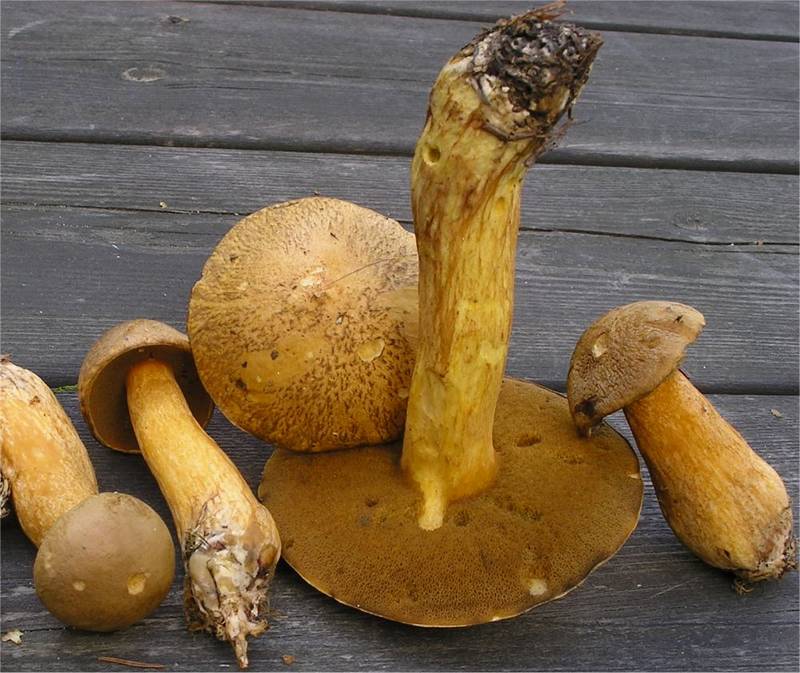
Photo by: Irene Andersson (irenea), CC BY-SA 3.0
Description of the motley flywheel
The diameter of the cap of the variegated flywheel reaches 10 centimeters. The hat is fleshy, convex, felt outside, dry. The color of the cap varies from dark brown to light brown. In places of damage and in cracks, the flesh is reddish. The edge of the cap is sometimes decorated with a red-purple edging.
The tubular layer of young specimens is pale yellow, and in mature specimens it is greenish. The tubules can be gray or yellow, and over time they turn olive. The pores are wide enough, if you press on them, they will darken noticeably.
The pulp is loose, yellow-white, at the cut it first turns a little blue, and then turns red. At the base of the leg, the color of the flesh is purplish red. Her taste is sweet, pleasant, and the smell is fruity and delicate.
The length of the leg reaches 9 centimeters, its diameter is 1-1.5 centimeters. The shape of the leg is even, cylindrical, narrowed downward. The leg is solid in structure. The color of the leg is light yellow or yellow-brown, reddish at the base. If you press on the leg, bluish spots appear.
Areas of growth of variegated flyworms
Motley moss are found mainly in deciduous forests, especially in which lindens grow. They do not grow abundantly, but they come across often.
Taste qualities of motley moss
Motley moss is an edible mushroom belonging to the 4th category. These mushrooms are harvested from July to October. Young fruit bodies can be fried and pickled, and they are also suitable for drying.
Other mushrooms of this genus
Velvet moss is an edible mushroom. The diameter of its cap is 4-12 centimeters. At first, the shape of the cap is spherical, but gradually becomes flat. The skin of the cap is velvety, but in mature specimens it is naked and even wrinkled.The color of the cap is variable: brown, purple-brown, red-brown, deep brown, sometimes there may be a pink tint. The leg is 4-12 centimeters high and 0.5-2 centimeters thick. The color of the leg varies from yellow to yellow-red.
Velvety mushrooms grow in deciduous forests, mainly under beech and oak trees, in addition, they inhabit coniferous forests. They bear fruit actively from late summer to early autumn. They grow mainly in groups. Velvet moss is suitable for all types of culinary processing: it can be fried, salted, boiled and dried.
Moravian moss is an edible mushroom. These are reserved mushrooms, they are extremely rare, so their collection is prohibited. The fine for collecting Moravian moss is 50 thousand kroons.
The cap of the Moravian moravian is orange-brown in color, its diameter is 4-8 centimeters. The shape of the cap in young fruiting bodies is hemispherical, but becomes prostrate over time. The hats of old specimens are covered with cracks. The leg is fusiform with pronounced veins. The length of the leg is 5-10 centimeters, and its diameter does not exceed 1.5-2.5 centimeters. The color of the leg is slightly lighter than the cap.
Moravian mushrooms bear fruit from summer to autumn. They grow in deciduous forests, plantings and pond dams. They are distributed mainly in the southern parts of the country.
Basket with variegated mushrooms.
Types of mushroom flywheel
Pan mushroom or chestnut flywheel (Boletus badius)
Also known as brown or polish mushroom.
The hat is 4-12 cm in diameter, the shape is semicircular, convex, later becomes cushion and even flat. The skin does not separate, the surface is smooth, dry, becomes sticky in wet weather, matte in young mushrooms, shiny in mature ones. Colored chestnut brown or brown. The pulp is fleshy, dense, whitish or yellowish in color, turns blue on the cut. The aroma is pleasant, mushroom. The leg is 4-12 cm high, 1-4 cm thick, cylindrical, narrowing or widening downward, fibrous structure, light brown, brown or yellow with red-brown fibers.
The mushroom grows next to pines, spruces, beeches, oaks, chestnuts, in conifers, sometimes in deciduous forests, singly or in small groups. The species is distributed in the northern temperate zone of the European part of Russia, in the North Caucasus, in Siberia, in the Far East. The season runs from June to November.
Good quality edible mushroom. Used for freezing, drying and pickling.
Fractured flywheel (Xerocomellus chrysenteron)
The diameter of the cap is 3-7 cm, the shape is convex or cushion-shaped, less often with a depression in the center, the surface is dry, matte, velvety or bare, burgundy-red, brown, olive-brown, brown, brown-red, ocher-gray. The hat cracks, forming a characteristic mesh. The pulp is white or with a yellow tinge, reddish at the base of the leg and under the cap, turns blue at the cut. Leg 4-10 cm in height and 1-2 cm in thickness, clavate, solid, smooth, fissured surface, light yellow with a red base.
The species is widespread in Europe, the North Caucasus, and the Far East. Grows in deciduous and mixed forests. Fruiting from July to September.
An edible mushroom that is eaten fresh and salted, and is also dried or frozen for use in fried and first courses.
Red flywheel (Xerocomellus rubellus)
The cap is 2-5 cm in diameter, cushion-convex in shape, flattens with age. Colored bright red. The skin does not separate, the surface is velvety-felt, cracks in mature mushrooms. The leg is cylindrical, tapering towards the base, 3-10 cm in height, about 1 cm in diameter, solid, fibrous, fine-scaled. The color of the stem is yellow with a raspberry-pinkish, reddish or reddish-brown base. The pulp is dense, yellow, turns blue on the cut.
The mushroom grows in deciduous forests, often in oak forests of Europe, North Africa, Asia.The harvest season lasts from August to September. Does not bear fruit abundantly.
An edible mushroom with a pleasant aroma, the taste is not expressed. Used fresh. Darkens on drying.
Green flywheel (Xerocomus subtomentosus)
The diameter of the cap is 3-10 cm, the shape is pillow-convex, the surface is velvety, grayish or olive-brown in color. The pulp is white, turns blue on the cut. The leg is cylindrical, tapers towards the base, 4-10 cm in height, 1-2 cm in thickness, the surface is smooth, the structure is fibrous.
Grows in coniferous and deciduous forests, in clearings, along roads, singly or in groups. It is a cosmopolitan mushroom, as it is distributed on all continents. Fruiting occurs in May-October.
An edible mushroom, used fresh. Darkens on drying.
Types of moss
In the genus Mokhovik (Xerocomus), there are 18 species, of which only seven are found in the vastness of Russia.
Polish mushroom (X. badius)
Photo of Polish mushroom
Reputed to be an excellent edible mushroom, one of the most delicious in Europe. It has a rather large size: the brownish cap sometimes reaches 12–15 cm in circumference, and the leg rises by 10–13 cm. Its flesh is fleshy, with a pleasant taste and a pronounced mushroom odor, whitish or slightly creamy yellow. Tubular layer of golden, later - olive-yellowish color, light brown spores. In Russia, it grows more often in coniferous forests on sandy soils, it is found in the European part, in the North Caucasus, in Siberia and on the island of Kunashir.
For more information, see the article "Polish mushrooms."
Good edible mushrooms are: red flywheel, green flywheel and motley or fissured flywheel.
Red flywheel (X. rubellus)
Photo of a red flywheel
A medium-sized mushroom with a rich red cap up to 8 cm in circumference, velvety-felt to the touch. It rises on a thin, up to 1 cm thick, stalk about 10 cm high, at the base with a pinkish salmon tint. The tubular layer is dull yellow, the spores are brick-brown. The species is collected only in deciduous forests, more often in the oak forests of Europe, the Far East, the mushroom is found in North Africa, but it is not called ubiquitous growing.
Green flywheel (X. subtomentosus)
Photo of a green flywheel
A mushroom with an olive-brown or grayish cap up to 10 cm in diameter and a cylindrical, slightly narrowed downwards, smooth stem up to 2 cm thick and 4 to 10 cm high, white flesh and yellowish hymenophore. It grows everywhere, both in deciduous and coniferous forests, it is found even on anthills. The area of distribution is extensive.
Flywheel variegated or fractured (X. chrysenteron)
Motley or fractured flywheel
A mushroom with a characteristic network of cracks on a small (3–7 cm in diameter) cap, which differs in different shades: burgundy-cherry, olive-chocolate, terracotta-red, ocher-gray. An unusual clavate shape is observed at a leg that grows up to 10 cm. Below, the leg is reddish with barely noticeable grayish-fibrous belts. The hymenophore is large-pored, creamy yellow or light olive in color, the spores are yellow-brown. Distributed everywhere: in coniferous and mixed forests on loose sour soil throughout Europe and the European part of Russia, in the Far East and the North Caucasus.
The conditionally edible species include the following types of moss:
- blunt (X. truncatus),
- chestnut (X. spadiceus),
- powdered (X. pulverulentus),
- woody (X. lignicola),
- semi-golden (X. hemichrysus).
The parasitic flywheels (X. parasiticus) and asteraceae (X. astraeicolus) were identified as inedible non-toxic fungi.
Description of velvet flywheel
The fruiting body of the velvet flywheel consists of a cap and a leg. The hat in diameter ranges from 4 to 12 centimeters. The shape of the cap in young velvet flyworms is spherical, but over time it becomes cushion-shaped and even reaches flat.
The cap, according to the name, is covered with a velvety skin, but with age, the surface becomes bare, sometimes wrinkles appear.In rare cases, old specimens develop cracks. A matte coating may be visible on the skin. The cap color is red-brown, brownish, purple-brown and bright brown. The caps of old flyworms often fade, sometimes they have a pinkish tint.
The mushroom pulp of the flywheel is velvety white or yellowish in color. If you press hard on the pulp or damage it, then it takes on a blue tint. The aroma and taste of the pulp is very pleasant and good. A characteristic feature of all mushrooms is the presence of a tubular layer.

The tubes contain pores of yellow-green, olive or bright yellow. The spores have a fusiform shape, their surface is ornamented.
A mushroom knife reaches 4-12 centimeters in length, and its thickness ranges from 0.5 to 2 centimeters. The leg is smooth to the touch. Its color varies from yellow to red-yellow. Microscopic studies have shown that amyloid hyphae of a thick-walled structure are located in the leg of the velvet flywheel, which are the main difference between this species.
Where do velvet mushrooms grow and when are they harvested?
Velvet moss grows in deciduous forests, they are mainly found under beech and oak trees. They can also grow in coniferous forests under spruce and pine trees. These mushrooms actively bear fruit from late summer to the first half of autumn. Velvet flyworms are found mainly in groups.

The edibility of velvet flywheels
Velvet moss is an edible mushroom. It is simply great for all types of culinary processing, and can be used in any form: boiled, fried, fresh, dried or salted, since its pulp is tasty and aromatic.
Similar types and their difference from the velvet flywheel
The variegated flywheel has an external resemblance to the velvet flywheel. But the variegated flywheel is distinguished by its smaller size, and a cracking cap of a yellow-brown color.
Fractured flywheel is also often confused with velvet flywheel. These mushrooms are found from summer to late autumn. The color of the cap of the fissured flywheel is brown, burgundy-red, ocher-gray or brown-red, and its characteristic feature is a cracking mesh pattern, while the color of the cracks is pinkish.

Cisalpine flywheel differs from velvet in larger spores, which are almost 5 microns larger. The cap of the Cisalpine flyworm cracks with age. His leg is short; when pressed, it turns blue. In addition, the flesh of this mushroom is paler than that of the velvet flywheel. Microscopic studies have shown that in the leg of the cisalpine flywheel there are waxy hyphae, while in the velvet flywheel there are none.
Growing a flywheel at home
As follows from the description, the mushroom mushroom grows only in symbiosis with the root system of trees, therefore, intensive industrial cultivation technologies, as in the case of champignons, are not applicable to it. However, unlike all the same buttermilk, flyworms can form mycorrhiza not only with conifers, but also with deciduous trees. This greatly simplifies their amateur cultivation in an ordinary orchard.
At the site of the future garden bed, a trench should be dug up to 30 cm deep. This hole is filled with a substrate consisting of forest land, branches, leaves and humus. It is better to take forest land where the flywheel mushroom grows.
A well-mixed substrate is placed in a trench so that a small slide is formed as a result. Then, old (this is an indispensable condition) pre-collected in the forest, flyworms are soaked in a bucket of clean water. After a day, the properly sour caps need to be kneaded with your hands to a mushy state and, together with water, evenly poured onto the mushroom bed. Thus, the natural conditions for the reproduction of fungi by spores are imitated.
If all goes well, the spores will begin to form mycelium. Unfortunately, it is very difficult to notice this process at first, therefore, in the first one or two months, the garden should be watered abundantly.If the inoculation is successful, the first fruiting bodies will appear no earlier than a year later. Since the mushrooms begin to bear fruit after the rains, this process can be stimulated with the help of watering.
Interesting information about the velvet flywheel
Synonyms for the name of the species are:
- Waxy moss;
- Frosty Mosswheel;
- Matte flywheel;
- Boletus fragilipes;
- Boletus pruinatus;
- Xerocomus pruinatus;
- Xerocomus fragilipes.
Velvet flywheel (Xerocomellus pruinatus) is an edible mushroom belonging to the Boletov family. In some classifications, it is referred to as Borovik.
The specific epithet "velvet", which is assigned to the described species, was adopted in connection with the most frequent use of this particular term in the Russian-language scientific literature. However, the most accurate designation of this type of mushroom can be called a frosty flywheel.
Shubnik mushrooms. Mushroom flywheel: description + Photo, how to cook? Edible and False + Video
 What a huge variety of species of moss mushrooms.
What a huge variety of species of moss mushrooms.
How do you learn to distinguish edible, tasty mushrooms from false bitters?
In this article, we will consider in detail almost all types of these delicious mushrooms, as well as analyze the features of collection, processing and storage.
Let's talk about the benefits and dangers of this type of mushroom and what you can cook delicious from them.
Detailed description of the flywheel
In summer, walking in the coniferous forest, you can find the flywheel mushroom. And they named it that way because of the place where it most often grows - moss.
Moss is a mushroom from the genus of edible tubular mushrooms, the Boletov family. Previously, all species were part of the flywheel genus, but later some of them were attributed to the genera Borovik and Pseudobolet.
The moss is considered a relative of the boletus. The variegated, green, polish and red mushrooms are the tastiest.
Hat
The hat of the flywheel is dry, a little velvety. In rainy weather, the hat can become sticky and damp. With the growth and aging of the fungus, as well as in dry weather, the cap becomes covered with scales, they appear from cracking of the cap.
The shape is semicircular and convex with smooth edges. The size can be reached from 4 to 20 centimeters in diameter. The pulp separates very poorly from the skin.
The color range of the flywheel cap is varied from light beige to dark brown, with many shades and tones.
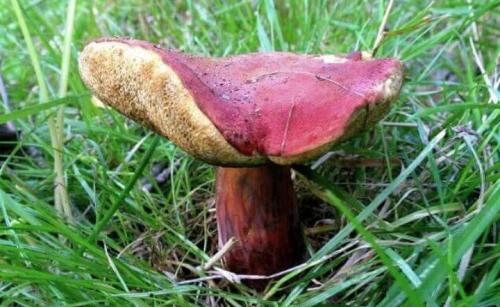
Leg
The leg of the flywheel, most often lighter than the cap. In shape, it is varied, it can be curved, it thickens from below, then in the center in some species even from above, closer to the cap.
The skin of the leg, depending on the species, is either smooth or ribbed or mesh. In length it can reach 8 cm. The Volvo and the ring on the leg are absent.
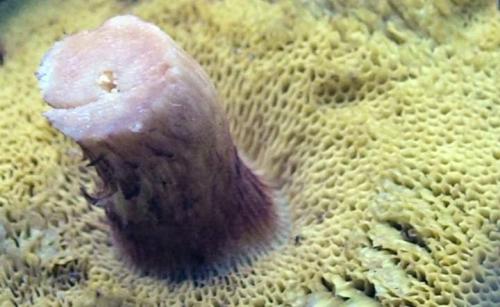
Pulp
By consistency, the pulp of the flywheel is compacted with a cotton-like center. On the cut, the pulp has a yellowish-beige color, less often reddish. One of the important features of this mushroom is the ability of the pulp to turn blue or black on the cut and when pressed with a finger.
Hymenophore
Geminophore is tubular, it can be up to 2 cm long. The mouth and pores of the tubes, both small and large, depend on the type of fungus. The color is also varied from yellow-green to yellow-brown shades.
There is also hymenium - on which spore-forming cells develop. Powdered spores are olive and all shades of brown.
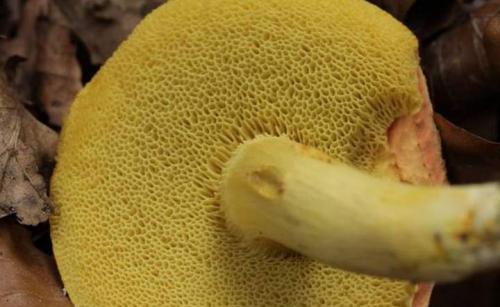
The ability of the flywheel to turn blue
This feature can in no way be attributed to signs indicating the toxicity of the mushroom. The substances in the pulp of the flywheel react with oxygen, the process of oxidation of the open surface begins when cut or broken. The formed dark film protects the fungus from subsequent damage.

Flywheel habitat
The habitat of the flywheel is vast and varied. It can be found in both coniferous and deciduous forests. Naturally, it can also be found in mixed forests. Moss loves sandy soil among mosses, it can also grow on anthills.
Some species can be found on stumps and trunks of fallen trees.Parasitic species of mushrooms grow on other myceliums, such as pseudo-raincoats. Flywheels form mycorrhiza with deciduous and coniferous trees.
The geography of distribution of the flywheel: Russia, Australia, North Africa, Asia, North America. In the forests of temperate latitudes.

Varieties of moss
There are no poisonous mushrooms among the flyworms. The truth about some species is controversial. Flywheels can be divided into several conditional groups: edible, false and poisonous mushrooms.
In Russia, you can find only 7 varieties of the flywheel, but in total there are 18 species in the genus.
For convenience, we will consider the main features of the flywheel varieties.
Polish mushroom
Hat: The cap of the Polish mushroom can grow up to 20 cm in diameter. The shape is similar to a dark brown cushion. The surface is sticky, but can be dry in hot weather.
Leg: The leg reaches 10 - 12 cm in length and up to 4 cm in width. The color of the leg is brown, but always lighter than the cap.
A mushroom that looks like a flywheel. Does the mushroom fly blue
Sometimes in the forests there are fungi growing in areas overgrown with moss. These are flyworms belonging to the genus Bolet. They got their name from their place of growth. Among them, there are species unsuitable for human consumption. To make sure whether the mushroom found is edible, determine whether the flywheel turns blue on the cut or not.
Does the mushroom fly blue
Distribution locations
Flywheels grow mainly in coniferous forests, and sometimes they can be found in mixed forests of temperate latitudes, on the slopes of ravines, at the bases or in the trunks of fallen trees. Most often they grow one at a time, less often - in small groups, forming a dense plexus of mycelium and moss. In addition to mycorrhizal species, soil saprotrophs are also present among the moss. Mass collection period: from early summer to late autumn. Among them there is an interesting species - parasitic flyworm, the place of residence of which is the fruiting bodies of pseudo-raincoats.
How to distinguish dangerous from edible mushrooms
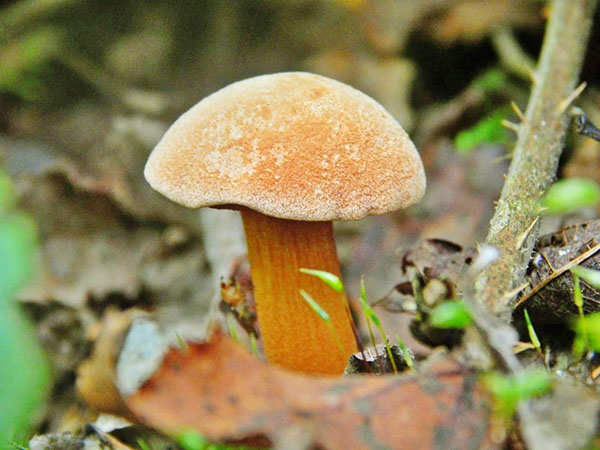
Doubles taste bad. In sire and dried form, they contain bitterness, which does not always disappear even during heat treatment.
Moss twins:
- Chestnut. The hat is brownish-red. The pulp is snow-white, does not change its color. It is this mushroom that is often confused with the Polish mushroom.
- Bile. Such a flywheel grows from June to October. The cap is slightly wavy at the edges. It contains a pink liquid that gives the bitter taste. The gall fungus is never damaged by insects.
- Pepper. The hat is light brown, convex. The pulp is light with a yellowish tinge. On cut, such a mushroom changes its color to red.
Knowing all the features of mushroom mushrooms, you can provide your whole family with healthy and tasty preparations. The main thing is not to confuse false and edible specimens, otherwise the dishes will be spoiled.
Chestnut mosswheel. Site of the "Quiet Hunt" lovers
Chestnut mosswheel
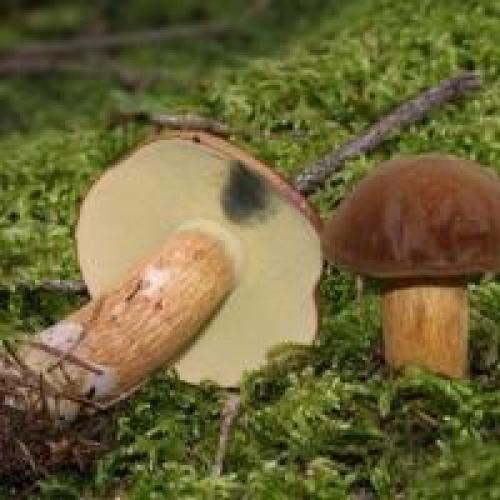
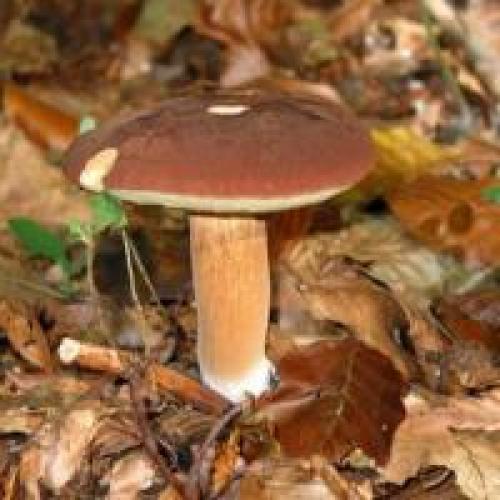

Edible
Tubular
The Polish mushroom (Latin Boletus badius) is a type of mushroom, in various classification systems attributed to the genera Boletus or Moss (Xerocomus), or allocated to a separate monotypic genus Imleria. The Russian names for the mushroom are also brown mushroom, pan mushroom and chestnut moss.
Synonyms:
- Flywheel brown
- Flywheel dark brown
- Boletus spadiceus
- Xerocomus ferrugineus
Chestnut Mosswheel or Mosswheel brown (lat. Xerocomus spadiceus) is an edible tubular fungus of the third category of the Boletov family. The name is given to the mushroom because of its frequent germination in moss. The family of mushrooms is not very nutritious.
It grows everywhere, it is often found. Prefers mixed forests, grows in conifers. Loves acidic soils. Most often it grows in large groups. Mycorrhizal forming agent (usually with birch, spruce, less often with beech and bearberry). The species of this fungus grows in huge numbers and is widespread.The distribution area covers the European part of Russia and the vast Belarusian forests. In appearance, this mushroom is similar to the related green flywheel and red flywheel, which differ from it in the color of some of their parts. The fungus often grows in colonies in forests of various mixed types, as well as along embankments and forest paths. It occurs mainly in summer and autumn. In damp weather, it acquires a whitish mold coating that infects other nearby fungi.
The fruiting body is a pronounced stem and cap.
The caps of young mushrooms have a hemispherical shape, then become more vague, outstretched. Sizes - up to 8-10 centimeters. The color ranges from yellow, light brown to olive. In rainy weather, the cap can be dark brown in color, and a white coating is often formed on it. If other mushrooms grow nearby, plaque from the flywheel can pass on to them. In mature mushrooms, the velvety skin becomes covered with light cracks. The fungal tubular layer has rather large pores. The light pulp does not change its color when exposed to it; as the fungus grows, it becomes soft.
The flesh of the mushroom is very juicy, while on the cut it does not change its color, remaining whitish-creamy. In young mushrooms, the flesh is hard, tough, in mature ones it is soft, a bit like a sponge.
The leg of Xerocomus ferrugineus has the shape of a cylinder, reaching a height of about 8-10 centimeters. In some specimens, it can be quite curved. The color is olive, yellowish, below - with a pink or slightly brown tint. The spore powder that appears during active fruiting has a pale brown color.
The brown flywheel grows in summer and autumn, the season is from late June to late October.
In terms of edibility, it belongs to the 3rd category.
Brown moss is well known to amateurs and experienced mushroom pickers. It has excellent taste. The mushroom can be boiled, fried, it is suitable for pickling and pickling. It is added to various soups and mushroom sauces. It can also be served on the festive table as a decoration.
In mixed forests, near embankments in late summer and autumn, you can see the mushroom Xerocomus ferrugineus. Mushroom pickers appreciate the brown flywheel for its excellent taste, using it boiled and fried. It can also be used for pickling, pickling.
Species similar to it are variegated moss and green moss. In the first species, there is a color-changing pigment layer under the cap, but in the green flywheel, when cut, the pulp acquires a yellowish tint.



